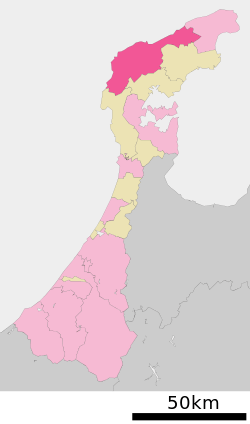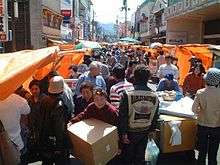Wajima, Ishikawa
| Wajima 輪島市 | ||
|---|---|---|
| City | ||
| ||
 Location of Wajima in Ishikawa Prefecture | ||
 Wajima Location in Japan | ||
| Coordinates: 37°23′N 136°54′E / 37.383°N 136.900°ECoordinates: 37°23′N 136°54′E / 37.383°N 136.900°E | ||
| Country | Japan | |
| Region | Chūbu (Hokuriku) | |
| Prefecture | Ishikawa Prefecture | |
| Government | ||
| • Mayor | Fumiaki Kaji | |
| Area | ||
| • Total | 426.25 km2 (164.58 sq mi) | |
| Population (January 2008) | ||
| • Total | 31,532 | |
| • Density | 74/km2 (190/sq mi) | |
| Time zone | Japan Standard Time (UTC+9) | |
| City Hall Address |
2-29 Futatsuyamachi, Wajima-shi, Ishikawa-ken 928-8525 | |
| Website |
www | |
Wajima (輪島市 Wajima-shi) is a city located in Ishikawa Prefecture, Japan. The city was founded on March 31, 1954.
As of 2008, the city has an estimated population of 31,532 and a population density of 74 persons per km². The total area is 426.25 km².
On February 1, 2006, the town of Monzen (from Hōsu District, and previously from Fugeshi District before March 1, 2005) was merged into Wajima.
Noto Airport serves Wajima.
On March 25, 2007, the 2007 Noto earthquake caused one death, injuries, and property damage in Wajima and other parts of Ishikawa Prefecture.
Climate
Wajima has a humid subtropical climate (Köppen climate classification Cfa) with very warm summers and cool winters. Precipitation is quite heavy throughout the year.
| Climate data for Wajima, Ishikawa (1981-2010) | |||||||||||||
|---|---|---|---|---|---|---|---|---|---|---|---|---|---|
| Month | Jan | Feb | Mar | Apr | May | Jun | Jul | Aug | Sep | Oct | Nov | Dec | Year |
| Average high °C (°F) | 6.1 (43) |
6.5 (43.7) |
9.9 (49.8) |
15.9 (60.6) |
20.3 (68.5) |
23.5 (74.3) |
27.5 (81.5) |
29.8 (85.6) |
25.8 (78.4) |
20.5 (68.9) |
14.8 (58.6) |
9.4 (48.9) |
17.5 (63.48) |
| Daily mean °C (°F) | 3.1 (37.6) |
3.1 (37.6) |
5.7 (42.3) |
11.0 (51.8) |
15.7 (60.3) |
19.6 (67.3) |
23.9 (75) |
25.7 (78.3) |
21.6 (70.9) |
15.9 (60.6) |
10.5 (50.9) |
6.0 (42.8) |
13.5 (56.3) |
| Average low °C (°F) | 0.2 (32.4) |
−0.2 (31.6) |
1.5 (34.7) |
5.9 (42.6) |
11.1 (52) |
16.0 (60.8) |
20.6 (69.1) |
22.0 (71.6) |
17.8 (64) |
11.5 (52.7) |
6.4 (43.5) |
2.5 (36.5) |
9.6 (49.3) |
| Average precipitation mm (inches) | 212.3 (8.358) |
141.7 (5.579) |
133.3 (5.248) |
113.2 (4.457) |
127.6 (5.024) |
163.4 (6.433) |
201.8 (7.945) |
155.8 (6.134) |
213.5 (8.406) |
156.4 (6.157) |
227.9 (8.972) |
253.6 (9.984) |
2,100.5 (82.697) |
| Average snowfall cm (inches) | 84 (33.1) |
71 (28) |
17 (6.7) |
0 (0) |
0 (0) |
0 (0) |
0 (0) |
0 (0) |
0 (0) |
0 (0) |
1 (0.4) |
27 (10.6) |
200 (78.8) |
| Average relative humidity (%) | 74 | 73 | 71 | 70 | 73 | 79 | 81 | 79 | 79 | 76 | 75 | 75 | 75.4 |
| Mean monthly sunshine hours | 43.3 | 64.5 | 127.4 | 187.5 | 201.9 | 157.2 | 156.1 | 206.8 | 138.2 | 142.0 | 88.4 | 51.6 | 1,564.9 |
| Source: Japan Meteorological Agency | |||||||||||||
Wajima Lacquerware
The town is known within Japan for its lacquerware, called Wajima-nuri (輪島塗). There are artifacts showing lacquer was used to decorate and strengthen a shrine door from the 14th century. Wajima-nuri uses a technique that is unique to the area, mixing a finely powdered mineral, jinoko, with the lacquer in the early stages of production. Jinoko adds extra durability to Wajima-nuri items. The rougher, earlier layers are then coated with more layers of finer lacquer, which is then polished to a lustrous shine, and often decorated with designs made of gold and other precious materials. The lacquer tree was once abundant in the area, but is now scarce and most of the lacquer used is imported from China.
Wajima Morning Market

The Wajima Morning Market (輪島朝市) is open every day except the 2nd Wednesday and 4th Wednesday of each month (and January 1–3 every year). Opening Hours are from 8:00 - Noon.
Visitors can stroll freely through the many stalls of fresh seafood, lacquerware and other handicrafts.
1000 Rice Fields (千枚田)

Senmaida (1000 Rice Fields) is one of the most scenic places in Ishikawa. There are actually 1004 fields which are either owned and tended to by families, or rented out and looked after by the locals.
Senmaida is beautiful in each of the four seasons and visitors can both view it from above, or take a leisurely stroll through the fields below.
Each year in the last week of September two lucky couples will be drawn from a nationwide lottery to have their wedding ceremony take place at Senmaida. The event is open to the public to view and is a very memorable experience.
As a memorial to the Noto earthquake, a tradition of lighting the fields began. Initially this was done with millions of candles placed around each field following the harvest, but due to the popularity of the spectacle, solar LED lanterns were purchased allowing the fields to be lit nightly. The lanterns are installed at the end of September and are left up through March when work on the fields begins again. The fields remain lit for about four hours after sunset.[1]
Kiriko Museum
Wajima's museum of Kiriko (キリコ) lanterns is open every day of the year from 8:00am to 5:00pm (8:30am to 4:00pm from December to February)
Entry is 600 yen for adults, 430 yen for high school students and 350 yen for elementary school students.[2]
Wajima Taisai (輪島大祭)
Every year from August 22 till the 25th Wajima comes alive with its famous 4-day festival.
Visitors can watch huge (10 meter tall) Kiriko lanterns being carried through the streets as well as smaller portable paper lanterns are carried through the town streets along with portable shrines called 'omikoshi'. Visitors can also eat all sorts of delicious festival foods, hear Taiko drums being played and watch the main event. At the festival climax, a special torch bonfire(4 or 5 storey high)by the sea is lit, and Gohei (decorative strips of white paper used in Shinto rituals), the torch is pulled down to the ground by competing groups. Men fight each other to take pieces of the delluge bamboo (with Gohei tied to them) as it is a symbol of good fortune. The men that manage to get their hands on the Gohei then climb to the top of their respected Kiriko to hang their prize and increase good fortune to their village for that year. It is also believed that the person who catches Gohei strips achieves success in everything he does. The giant Kiriko lanterns are indispensable to various festivals celebrated in Noto. Wajima's festival kirikos are especially distinctive because of their famous magnificent Wajima lacquer coatings, a three character Kanji poem, and on the reverse side the town's crest from where the people who carry that particular Kiriko reside.
The Story of the Taisai (Great Festival) depicts the love story between two Kami (gods); the Kami of the Forrest (a half blind male deity) and the Kami of the seven islands (the female deity) that lays just off the coast of Wajima. Once every year the people of Noto guide the male Kami from his forest home through the city, while stopping off at every business, home and shrine to give blessings to the people of Wajima, and eventually to meet his wife at the sea. In order to guide him they must carry bright lights (the Kiriko) and beat taiko (drums) that are attached within the Kiriko. The taiko of Noto are generally played by two or more people, with the base beat played by the Kobi and the main rhythm played by the Obai on a shared taiko. Shinabue and Atarigane accompany.
The main event takes place on the 3rd night of the festival at midnight at Wajima Marine Park.[3]
Gojinjo-daiko (御陣乗太鼓)
Gojinjo-daiko (御陣乗太鼓) is a Japanese drumming style, which is elected as a Wajima City’s cultural heritage (appointed in 1961) and an Ishikawa Prefecture’s intangible cultural heritage(appointed in 1963), consisting a part of Noto, Ishikawa’s GIAHS (Globally Important Agricultural Heritage Systems), which was appointed in 2011 as the first area in Japan by Food and Agriculture Organization.[4][5]
Playing gojinjo-daiko is strictly restricted into resident in Nafune, a small village in Wajima City, where only 250 people live so that it is very rare to see live drum performance.[6]
The origin of the gojinjo-daiko dates back to 1577 when the famous general, Uesugi Kenshin invaded the Noto, Ishikawa. Because local people of the area had no single weapon, they resisted by bravely beating war drums and wore ferocious looking devil masks with seaweed on their heads in a bid to scare off their enemies. The low sound of drums sound associated with the rumbling of the earth and Uesugi Kenshin and his solder finally escaped away.[7][8][9]
North American Taiko groups, such as San Francisco Taiko Dojo, and Nagata Shachu, are known to have performed similar (but non official) versions of Gojinjo-Daiko.
Wajima Crab Festival
The Wajima Crab Festival (輪島かに祭り) takes place each year in mid-November. Visitors can purchase all sorts of fresh seafood and sit at one of many large, long tables and barbecue their own meal.[10]
Kanakura Light Festival
Kanakura is a town in the northern part of the Noto Peninsula in Ishikawa Prefecture, Japan. It is a small, peaceful village with ancient temples and rice terraces. This town celebrates an annual light festival (matsuri) in which the residents place one candle in each of 10,000 sake bottles and then arrange them in geometric configurations after dark while listening to traditional Japanese music.
See also
References
- ↑ http://mainichi.jp/english/english/newsselect/news/20151013p2a00m0na004000c.html
- ↑ Archived May 25, 2009 at the Wayback Machine
- ↑ Archived August 21, 2009 at the Wayback Machine
- ↑ "Noto’s Satoyama and Satoumi Gallary". Noto Regional GIAHS Executive Committee. Retrieved 2012-06-11.
- ↑ "GIAHS appointment". Ishikawa Prefecture. Retrieved 2012-06-11.
- ↑ "Gojinjo Daiko". Gojinjo Daiko of ART. Retrieved 2012-06-11.
- ↑ "att Japan Travel Guide". Finex Co., Ltd. Retrieved 2012-06-11.
- ↑ "att Gojinjo Daiko". Wajima City. Retrieved 2012-06-11.
- ↑ "Nahune Gojinjo Daiko". Ishikawa Prefecture Tourism League. Retrieved 2012-06-11.
- ↑ "輪島の魚を食べよう!加能ガニ(石川県産ズワイガニ)解禁2012|JF石川輪島支所". Jf-net.ne.jp. Retrieved 2012-12-23.
External links
 Media related to Wajima, Ishikawa at Wikimedia Commons
Media related to Wajima, Ishikawa at Wikimedia Commons Wajima travel guide from Wikivoyage
Wajima travel guide from Wikivoyage- Wajima City official website (Japanese)
| ||||||||||||||||||||||||||||
|
